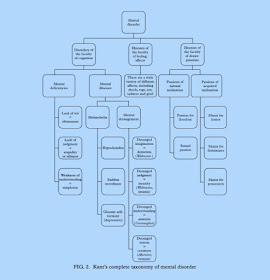 |
| Kant dines with friends (by Emile Doerling) |
The philosophers here do not come off looking good, which was probably Onfray’s aim. (According to Wikipedia, Onfray promotes hedonism, atheism, and anarchism, and is the highly prolific author, “having written more than 80 books.”) But perhaps the peccadilloes on view here are only more systematized variants of contemporary gastronomic obsessions. I was naturally interested in Kant.
Although Kant is known in the popular imagination as a man of regular, even abstemious, habits, in turns out that he was quite intemperate in his younger days. In the 1760s, for instance, he was known to have often been inebriated: he played billiards and cards in a cafe and often drank so much that, according to Onfray, “he could not find his way back to his home on the Magistergasse in Königsberg.” He “pulled himself together,” however, and went on to create a theory of drunkenness from his experience. The anecdotes in Onfray’s account of Kant’s dining and drinking preferences are drawn from contemporaries of the philosopher (Reinhold Bernhard Jachmann, E.A.C. Wasianski, and Louis Ernest Borowski), which appear in a book in French entitled Kant intime. I do not know what role these accounts play in biographies of Kant by modern-day scholars, but apparently Kant’s contemporaries were intrigued by them, including the English writer Thomas de Quincy, whose 1827 essay The Last Days of Immanuel Kant is (according to J.E.H. Smith) “a massively long quotation, in English translation, of Ehregott Andreas Wasinski’s 1804 work, Immanuel Kant in seinen letzten Lebensjahren.”
A curious French video on this work by de Quincy can be found here.
 |
| Charles Fourier's Table of the Passions |
Onfray mentions another work, The Conflict of the Faculties (1797), in which Kant devotes a chapter (“On the Power of the Human Mind”) to hypochondria. Kant confessed his own disposition to that condition, caused by a “ flat and narrow chest, which leaves little room for the movement of the heart and lungs; and in the early years this disposition made me almost weary of life. But by reflecting that, if the cause of this oppression of the heart was purely mechanical, nothing could be done about it, I soon came to pay no attention to it.” That sounds like a good piece of practical philosophy. And, indeed, in The Conflict of the Faculties, he recommended the Stoic way of life because it unites “the doctrine of virtue” with “the science of medicine”: “Medical science is philosophical when the sheer power of man’s reason to master his sensuous feelings by a self-imposed principle determines his manner of feeling.”
 |
| Kant's Taxonomy of Mental Disorder |
I was led to an article by Patrick Frierson entitled “Kant on Mental Disorder,” which concerns Kant’s “anthropology.” Frierson notes that “much of Kant’s preoccupation with hypochondria throughout his life – and arguably his concern with mental disorder in general – can be traced to his efforts to combat this looming mental disorder of his own.” The article discusses the nature of Kant’s “pragmatic anthropology” contained in several writings, including his Anthropology from a Pragmatic Point of View (published 1798), which reflects the lectures he taught from 1772 until 1796. Apparently mental disorder was a popular philosophical subject in the late 18th-century, but Kant's writings were a kind of “philosopher’s guide to help ordinary people with self-treatment,” especially with what “he elsewhere connects with ‘the power of the mind to master its morbid feelings by sheer resolution.’” Kant’s tone throughout is playful and informal, not technical or medical, and he does not speculate on the physiological origins of mental disorders. Again, the emphasis is on pragmatism. The editors of the English edition of Anthropology state that its focus is what the human being “as a free-acting being makes of himself or can and should make of himself.”
As Frierson writes: “He provides an entertaining guide for diagnosing and dealing with peculiarities that arise in society, not a Diagnostic and Statistical Manual for professionals.” An example of Kant's playful tone and his avoidance of extreme cases is shown by “offering examples that would be intuitive and available to his audience, such as that ‘the person who falls in love is inevitably blind to the faults of the beloved object, though the latter person will usually regain his sight eight days after the wedding.’”
A final note: Kant’s schema of mental disorders has to my mind an uncanny resemblance to the categorizing of emotions articulated by the French utopian philosopher Charles Fourier. I have written on Fourier earlier (see this post), in connection with my work on utopia, but allow me here only to illustrate, by way of the two diagrams above, the hairsplitting that reason inevitably leads to.
Picture credit: Patrick Frierson (table of mental disorder); The Maverick Philosopher

No comments:
Post a Comment